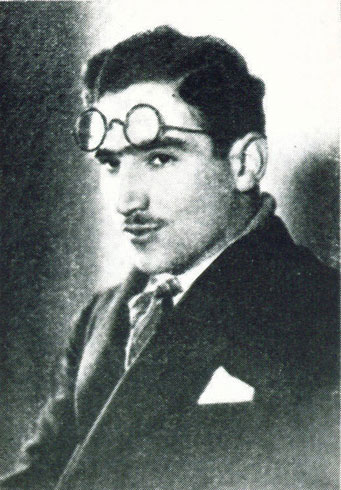
אלכסנדר פורד
- “ This institutional film was produced by the Jewish Labor Bund to raise funds for the Vladimir Medem Sanatorium which, noted for its modern and spacious facilities, stood as the embodiment of health and enlightenment, in striking contrast to the grim images of urban Polish-Jewish poverty." See Fritz Bauer Institute Cinematography of the Holocaust - see under: Ford, Mir Kumen On/Droga Mlodych, Record No. FBW002959).
- גרוס, נתן: תולדות הקולנוע היהודי בפולין 1950-1910 , הוצאת מגנס, האוניברסיטה העברית, תש"ן, עמ' 42. רוב המקורות שמצאתי מציינים כי פורד התאבד, אבל נראה שהם מעתיקים זה את זה. נתן גרוס ועומר ברטוב אינם מזכירים התאבדות. ר' גם את ספרו המאלף של Coates, Paul: The Red and the White: The Cinema of People's Poland, Wallflower Press, London & New York, 2005, p.184: "A Jew himself, he had broached Jewish themes in the pre-war cinema and would later be driven abroad by the anti-Semitic campaign of 1968, dying in exile." גישה מתפשרת וזהירה מתבטאת בספרם של Michałek, Bolesław and Turaj, Frank: The Modern Cinema of Poland, Indiana University Press, Bloomington and Indianapolis, 1988, p. 48: המציינים שסיבת מותו של פורד הייתה "כנראה התאבדות".
- ראשי תיבות בפולנית של "החברה לקידום אמנות הקולנוע", Haltof, Marek: Polish National Cinema, Berghahn Books, New York and Oxford, 2002, p.37.
- Michałek and Turaj, op. cit., pp.5-6.
- Haltof, op. cit., p.37
- פלדשטיין, אריאל ל', חלוץ, עבודה, מצלמה: הקולנוע הארצישראלי והרעיון הציוני 1939-1917, עם עובד , תל אביב, 2009, עמ' 132.
- הסרט אכן צולם בארץ, אך ללא סאונד: "הסרט צולם ללא קול, והדיאלוגים הושלמו בורשה באמצעות דיבוב של שחקנים דוברי עברית, יידיש וערבית." פלדשטיין, שם, עמ' 133.
- פלדשטיין, שם, עמ' 139.
- גרוס, נתן, שם ,עמ' 83.
- Haltof, op. cit., p. 45: "Although some filmmakers survived the occupation in Poland…the majority left after September 1939…Others, mostly filmmakers associated with prewar leftist groups, survived the war in the Soviet Union and created a film unit Czołớwka (Vanguard) within the Polish Tadeusz Kościuszko First Division, which fought alongside the Red Army. Alexander Ford, Jerzy Bossak, Stanisław Wohl, and Ludwik Perski, all prewar START members or followers, returned with the Red Army as officers in the Kościuszko Division." See also: Bartov, Omer: The "Jew" in Cinema: From 'The Golem' to 'Don't Touch My Holocaust', Indiana University Press, Bloomington and Indianapolis, 2005, p. 179.
- Bartov, op. cit., p.179, and note 97, p. 349; see also Fritz Bauer Institute Cinematography of the Holocaust under above-mentioned film title, Record Number FBW002859.
- Michałek and Turaj , op. cit., p.3: "In the first peacetime months there were two parallel temporary film administrative units, one military and the other civilian. The chief of each was the same man, Aleksander Ford."
- Michałek and Turaj, ibid.
- לדוגמה, רומן פולנסקי המצוטט על ידי Misiak, Anna: "Politically Involved Filmmaker: Aleksander Ford and Film Censorship in Poland after 1945", p.1מאמר זה מצייר דיוקן מורכב של פורד כרודני ותאב שררה מצד אחד וכאדם חסר יכולת ונרדף מצד שני, דיוקן המתבסס בעיקר על עדויותיהם של יריביו של פורד, והוא בעל נופך של רכילות, אם לא של אנטישמיות. הלטוף גם מביא את טענת הרודנות של פורד, אך ללא סימוכין.
- Misiak, op. cit., p.5.
- האחים גוסקינד זכורים לנו כיוצרי הסרט "חמש ערים" (פולין, 1939), בין המסמכים הקולנועיים האחרונים על חיי היהודים השוקקים בערי פולין הגדולות ערב מלחמת העולם השנייה.
- גרוס, נתן, שם, עמ' 91-90.
- גרוס נתן, שם, עמ' 92-90.
- Haltof, op. cit., .p.48.
- Haltof, op.cit., p.52.
- Coates, op. cit., pp. 184-185.
- Coates, ibid; Bartov, op.cit., p.186. לפי ברטוב, היהודים הלוחמים בסרט מתים כיהודים, אך נהפכים ל"פולנים הירואיים" לאחר מותם, בנסיבות של פולין לאחר המלחמה.
- Haltof, op.cit., p. 52.
- ה"ויקיפדיה" של הקולנוע, ה-IMDB, מציין שרחוב גבול נפסל על ידי הצנזור הפולני, אך לא מצאתי סימוכין לטענה הזאת במקור אחר.
- Haltof, op.cit., p.65.
- Haltof, op.cit.,p.103, and n.86, pp.108-109.; see also Crowther, Bosley, "The Eighth Day of the Week (1958), Screen: Warsaw Story; 'Eighth Day of Week' Cites Housing Need", The New York Times, March 24, 1959: "…this slightly naive romantic drama seems mild and innocuous, scarcely worth all the hurrah the Polish Communists have made over it! Films much more critical of conditions in the countries in which they were made have come in recent years from Italy, France and even the United States… why the Communists have scored its Polish makers and put obstructions in the way of its being distributed in Europe is a bit hard to understand. Perhaps they feel that two properly ardent comrades shouldn't be discouraged by such a small thing as not having a home." quoted from>
- Haltof, op. cit., n.86, pp.108-109, and p.97.
- Haltof, ibid.
- Coates, op.cit., p.97: "What was it that made Korczak, a nonbeliever and a potential 'secular saint' …so potentially difficult a subject for the cinema of People's Poland? The nature of the difficulty can be gauged by perusing the minutes of the 1967 'Studio' film unit meeting that accepted a screenplay to be filmed by that cantankerous grand old man of Polish cinema, Ford…the meeting concluded by demanding various changes…to bring the script—the work of a non-Pole, Aleksander Ramati, into line with Polish state ideology. "
- Coates, op.cit., p.99.
- Coates, ibid.
- אתה חופשי, ד"ר קורצ'אק (המשפט שלכאורה נאמר לקורצ'אק על ידי קצין ס"ס לפני עלייתו לרכבת עם ילדי בית היתומים).
- Fritz Bauer Institute Cinematography of the Holocaust - www.cine-holocaust.de- see under "Korczak", Record Number FBW001239.
- Coates, ibid.




